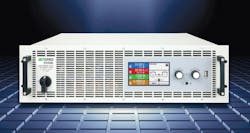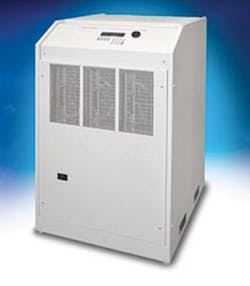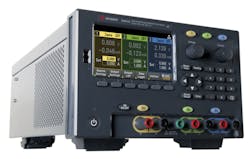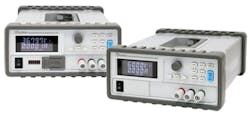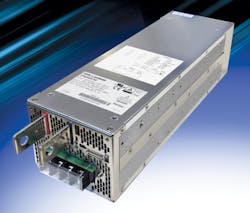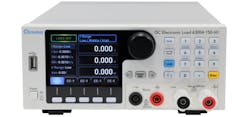Power supplies and loads are key tools in the test of products ranging from highly efficient communications ICs to high-power automotive-drive-train and battery systems. Physical configurations range from benchtop units to floor-standing cabinets.
“Today’s complex electronic designs place higher demands on the systems that power them,” said Bill Griffith, application engineering manager at Keysight Technologies, speaking of power supplies at the launch of Keysight’s latest model. “But these power systems often cause design problems, and basic power supplies may be incapable of uncovering them.”
As for loads, companies recently have introduced both regenerative and dissipative versions since our last look at the topic.1 Gerard Sheehan, Intepro Systems’ chief technical officer, commented that the regenerative feature is valuable because it minimizes the need for expensive cooling systems used by conventional air- and water-cooled loads. However, Herman vanEijkelenburg, director of marketing at Adaptive Power Systems, which makes both regenerative and dissipative loads, notes the dissipative loads can provide higher dynamic-current slew-rate performance.
Electronic load details
Intepro Systems’ latest load offering is the ELR 9000 HP Series regenerative, programmable electronic DC load, designed to accommodate three-phase mains between 360 and 528 VAC (Figure 1). “The wide input voltage of the new ELR 9000 HP Series of electronic DC loads is especially important to our customers that have manufacturing facilities in multiple global locations,” said Sheehan.
Courtesy of Intepro Systems
Each unit provides load ratings of up to 15 kW in a single 3U rack-mounted instrument. A master-slave bus can connect as many as 16 units in parallel to test loads of up to 240 kW. The company said a unique feature of the ELR 9000 HP Series is an integral, grid-synchronized inverter designed to return up to 94.5% of the load test energy back to the grid.
Adaptive Power Systems’ latest initiative with regard to programmable DC loads is an upgrade to its 5VP line to support master/slave parallel operation (Figure 2). Individual 5VP loads support power levels from 5 kW to 60 kW each; with the upgrade, up to eight loads can be paralleled to support extended-range, high-power electric-vehicle battery-test applications.
Courtesy of Adaptive Power Systems
The new 5VP Series loads offer a suite of built-in battery-discharge-profile functions which engineers can customize and execute without having to develop test software. Data on battery performance can be collected during these test discharge protocols.
According to Eric Lord, director of sales for Adaptive Power Systems and sibling company Pacific Power Source, “These high-power electronic loads are very cost-effective tools for development and test engineering. They represent a logical product line expansion to our existing AC source and DC power product lines. With the addition of master/slave operation, we now can offer programmable DC load solutions as high as 480 kW.”
Power supplies
As for power supplies, Pacific Power Source recently announced a range of high-power AFX Series integrated cabinet test systems, which consist of two or more integrated AFX AC- and DC-capable programmable power sources in a parallel configuration for power levels of 18 kVA and higher. All are prewired for AC input and AC/DC output. AFX power sources use a proprietary, all-digital power-conversion technology2 delivering higher power density than previously available, allowing a 45-kVA system to fit in a 33-inch bench-height cabinet, for example.
Also addressing high power, AMETEK Programmable Power has added a 22.5-kVA unit to its California Instruments MX Series II AC/DC power sources (Figure 3). The MX22.5 delivers up to 22.5 kVA and can be configured to have single-phase or three-phase outputs in the AC, DC, or AC+DC mode. The company describes the MX22.5 as more economical than the California Instruments MX30 while offering more features and higher output power than the product family’s MX15 model.
Courtesy of AMETEK Programmable Power
The MX Series II provides controlled AC and DC output for a variety of automated test equipment and product test applications through the use of PWM switching techniques. Using DSP technology, the MX Series programmable controller can generate harmonic waveforms and arbitrary waveforms to test for susceptibility to harmonics and other power anomalies.
Users can combine units to configure systems up to 135 kVA or more. The model also offers regenerative, bidirectional “green” power. Automatic crossover between source and sink power modes offers regenerative capabilities in AC or DC mode. The power sources can regenerate up to 85% of the rated output power back to the utility grid during sink mode operation when equipped with the appropriate option.
Benchtop supplies
As for benchtop supplies, Kikusui Electronics recently announced the PWR-01 Series DC power supplies (Figure 4), available in models offering 400-W, 800-W, and 1,200-W rated power and maximum rated voltage up to 650 V, offering a 30% increase in power density compared with the company’s previous model, the company reports.
Courtesy of Kikusui Electronics
The company cites variable internal impedance as a unique new feature that allows for various types of simulations suitable for automotive test, solar-panel evaluation, and other applications. The PWR-01’s soft-start function limits the inrush current. The PWR-01 also is equipped with ergonomic power setting knobs, allowing the operator to control voltage and current independently, as well as front-facing banana plugs.
The PWR-01 programmable internal-memory feature lets the operator save custom sequences on the device, eliminating the need to access a PC every time a test is conducted. Synchronized operation allows for complex sequences over multiple channels for accurate testing of DC/DC converters and other products. LXI, USB, and RS-232 interfaces come standard; the PWR can be operated in almost any testing environment via SCPI commands.
Keysight Technologies’ most recent entrant into the power-supply market is the E36300 Series 80-W and 160-W triple-output programmable DC power supplies (Figure 5), which offer a large color display and device connections via LXI, USB, and optional GPIB.
Courtesy of Keysight Technologies
“With the E36300 Series, engineers can simulate power problems early in the design cycle,” said Griffith. “And advanced features, such as low-current measurements, auto-series and auto-parallel connections, sequencing, and data logging, help them detect power problems.”
The E36300 Series’ low “normal-mode” noise specifications assure quality power for precision circuitry applications. In addition, the power supplies are acoustically quiet. Each model provides line/load regulation of 0.01%, fast transient response time of less than 50 μs, low-range current measurement, and overvoltage, overcurrent, and overtemperature protection to prevent damage to the device under test.
Keysight’s BenchVue software3 supports the E36300 Series, enabling control of power supplies to set parameters and status alerts, visualize power output, and log changing voltage and current over time. The included Test Flow capabilities let users automate power-supply setups and measurements into test sequences.
In related news, Chroma reports that its new power supplies, the 62000L Series (Figure 6), include built-in features designed to meet the requirements of next-generation automotive power electronics, communications devices, and semiconductor IC drivers. The initial release offers two models, the 62010L-36-7 and the 62015L-60-6 with specifications of 36V/7A/108W and 60V/6A/150W, respectively. Chroma offers a 19-inch rack-mounting kit for ATE integration.
Courtesy of Chroma
The supplies feature autoranging as well as fast transient response—for example, when the output current changes from half load to full load at the speed of 1 A/μs, the voltage change of the actual output can return to 15 mV within 30 μs.
The autosequencing programming function built into the 62000L Series allows the user to define and edit the output waveforms with eight steps per cycle.
Chroma says that conventional linear power supplies can be cumbersome due to the frequency design and require more space for ventilation. Chroma simplified the design of the hardware architecture, resulting in a better handling compact, lightweight design which is safer to stack.
Adaptable for test and measurement
Other companies recently have introduced supplies for use in test and measurement equipment and other applications. TDK, for example, recently added a 3,200-W, 48-V model (Figure 7) to its TPS power-supply series. The 2U-high product operates from a range delta or wye 350- to 528-VAC three-phase input. The 48-V model is suitable for use in many applications including test and measurement equipment, semiconductor fabrication, industrial printers, and lasers. The high-voltage, three-phase input avoids the requirement for step-down transformers and assists phase load current balancing.
Courtesy of TDK
In addition, Bel Power Solutions has expanded its ABC Series open-frame, AC/DC power-supply portfolio to include the low-profile ABC180, MBC180, ABC275, and MBC275 power supplies for industrial and medical applications. Specifically engineered for use in tight spaces, the high-efficiency units boast an ultralow profile of < 0.75 inch (19 mm). The ABC180/MBC180 units deliver 180 W of output power or 120 W with convection cooling, and the ABC275/MBC275 deliver 275 W with forced air-cooling or 160 W with convection cooling.
The ABC Series is suitable for use in an array of space-constrained OEM, industrial, instrumentation, test and measurement, telecom, and datacom applications, and the MBC Series is suitable for medical applications.
Several other companies also have recently made power-supply news. Excelsys Technologies, for example, announced that its CoolX600 Series 600-W convection-cooled modular power supplies now are available with a PMBus communication option. Pacific Power Source added a touchscreen monitor user-interface mode for the AFX Series, which extends the front-panel LCD touch and keypad controls onto a large, high-resolution monitor with touch capability. Intepro Systems debuted the Procyon line of integrated production test systems. Behlman Electronics said the DCS1000T-1, P/N 94039-1, has been enhanced to meet the shipboard input-power requirements of MIL-STD-1399, Section 300B. And Versatile Power said its BENCH XR line of 600-W programmable supplies provides accurate point-of-load voltage regulation without the use of an auxiliary remote-sense circuit. These innovations are described in more detail in an earlier issue.4
Courtesy of Chroma
Expect innovations in both power supplies and loads to continue. Indeed, as this article nears publication in late August, Chroma is introducing its newest programmable DC load—the compact and lightweight 63000 Series (Figure 8), primarily designed to test switching power supplies, A/D power supplies, power electronic components, adapters, batteries, and chargers. The company is offering initial release models in two operating voltages, 150 V and 600 V, with 250-W and 350-W power levels up to 60 A in a single unit. Each 63000 Series model comes equipped with Chroma features including CZ mode, user-defined waveforms (UDW), three current ranges, data setting storage/recall, and short-circuit simulation.
Steve Grodt, director of business development for Chroma, said, “Our new 63000 Series provides R&D labs a lower power solution at a low cost without having to give up advanced functionality and precision.”
Power technology roadmap
In related news, The Power Sources Manufacturers Association (PSMA) has announced the availability of the 2017 edition of The Power Technology Roadmap. The report forecasts the power technology and power delivery trends through 2021.
This year’s PTR integrates recent inputs from webinars, surveys, analyses, and discussions to offer a consolidated view of the latest trends in power management, power control, and power-delivery technologies.
New this year is a section titled “Component Technologies,” which contains overviews of each component segment as applicable to power electronics. Component segments represented include silicon IGBTs, MOSFETs, SiC devices, GaN devices, and ICs. The report also includes summaries from PSMA webinars related to passive components, such as capacitors and magnetics.
The report is divided into five sections:
- application trends,
- component technologies,
- emerging technologies,
- webinar presentations, and
- power supply and converter trends.
“Power electronics has emerged, or should we say re-emerged, as an enabling technology in its own right,” said Conor Quinn, co-chair of the organizing committee, in a press release. “Advancements in power are now shaping a large part of the electronics industry as a whole.”
Dhaval Dalal, co-chair of the organizing committee, added, “This latest edition of the PTR provides the most extensive, forward-looking view of our industry. It’s an invaluable resource for any organization involved in the power electronics technology marketplace.”
References
- Lecklider, T., “The loads are simulated, but the connections are real,” EE-Evaluation Engineering, September 2016, p. 8.
- vanEijkelenburg, H., “Advantages of digital switching in programmable AC power supplies,” EE-Evaluation Engineering, July 2017, p. 16.
- Nelson, R., “Speeding instrument setup, control, and communication,” EE-Evaluation Engineering, July 2017, p. 6.
- Nelson, R., “Powering chips and systems from FPGAs to shipboard equipment,” EE-Evaluation Engineering, June 2017, p. 28.

